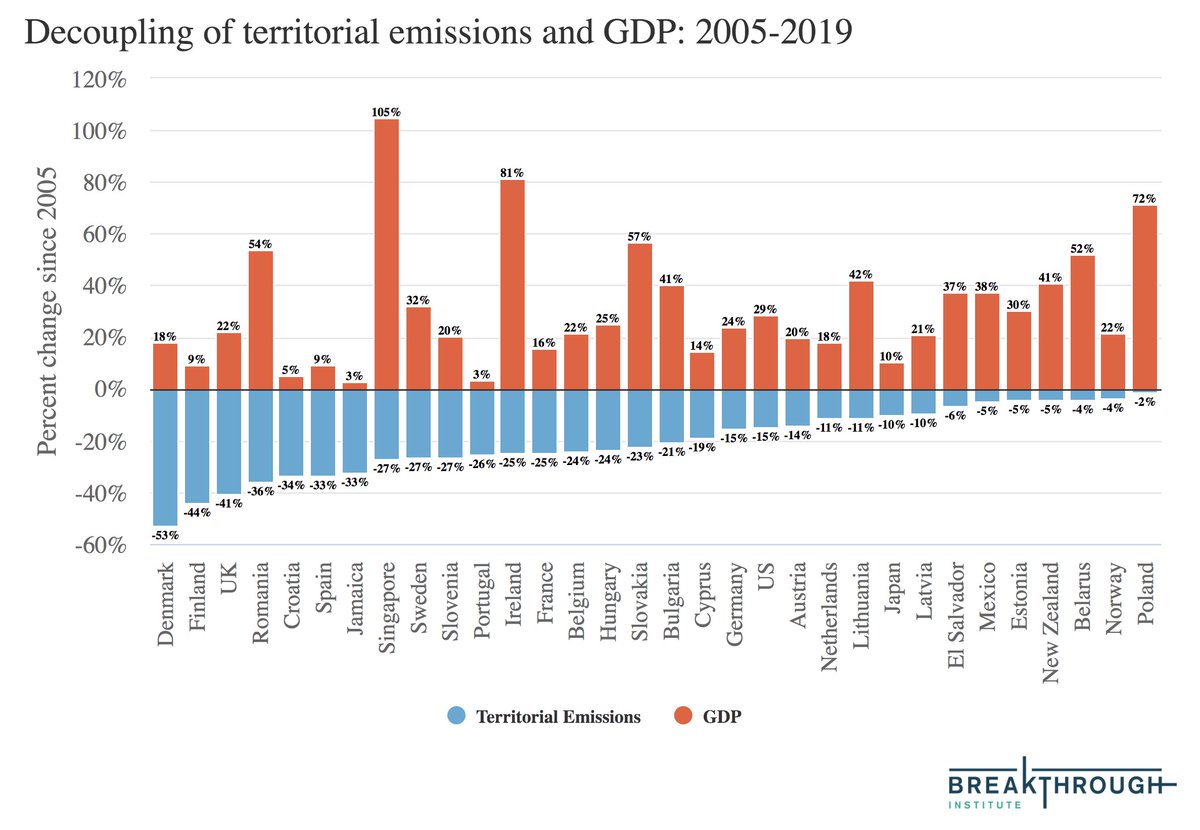
The US has committed to an ambitious goal of reducing emissions by 50% to 52% in 2030 relative to 2005 levels. In a new analysis, we look at what we are on track for today, and the additional reductions that would be needed to meet the new goal: thebreakthrough.org/issues/energy/… 1/16
The US has reduced its CO2 emissions by about 20% since 2005. However, nearly all those reductions have been concentrated in the power sector. If current trends continue, we expect US CO2 emissions to be around 30% lower than 2005 levels in 2030: 2/ 

In this current-trends-continue scenario, electric power sector emissions will fall 60% by 2030 compared to 2005 levels. Residential emissions will fall 18%, transportation emissions 15%, industrial emissions 5%, and commercial emissions will increase by 14%. 3/
This is pretty well in-line with the recent @IEA 2020 World Energy Outlook, which suggests that US CO2 emissions will be 31% below 2005 levels in 2030 in its Stated Policy Scenario. 4/
The additional reductions in CO2 emissions cannot happen in the power sector alone. Even fully eliminating power sector emissions by 2030 – an unlikely outcome given the timeframe and limitations of current clean electricity technologies – would only result in a 47% reduction. 5/
One possible pathway toward meeting the 50% target would involve a combination of accelerated power sector CO2 reductions, rapid electric vehicle uptake in the transportation sector, and a modest decline in other sectors relative to the current-trends-continue scenario. 6/
By 2030 this ambitious scenario would involve:
⬇ Zero coal use
⬇ 33% lower gas use
⬆ 50% of vehicle sales as electric (and 25% of the vehicle fleet)
⬇ 15% additional reduction in building and industry emissions relative to current trends continuing.
7/
⬇ Zero coal use
⬇ 33% lower gas use
⬆ 50% of vehicle sales as electric (and 25% of the vehicle fleet)
⬇ 15% additional reduction in building and industry emissions relative to current trends continuing.
7/

Here power sector emissions decline by 83% in 2030 relative to 2005 levels. Transport by 33%, residential by 26%, industrial by 19%, and commercial by 10%. The overall emissions declines are similar the @IEA's Sustainable Development Scenario. 8/
Something like this would be achievable – other countries like the UK and Denmark have already achieved closer to 50% cuts – but it will not happen through technology alone in a current policy world. thebreakthrough.org/issues/energy/… 9/
Even the policies currently proposed by the Biden administration – such as the infrastructure bill – would be unlikely to achieve this goal by themselves. It remains unclear what the political pathway might be to meet this target. 10/
While it is possible that political dynamics might change in the next nine years, the slow turnover of capital – particularly for transport and buildings – means that a transition to clean energy technologies needs to begin sooner rather than later across all of these sectors 11/
Another way to look at the scale of the challenge is to look at how the rate of decarbonization of the economy — the amount of CO2 emitted per unit of GDP — would have to change to meet the 2030 target: 12/ 

The 50% target would require a dramatic expansion of the rate of decarbonization. Since 2005 the US has decarbonized its economy at an average rate 3.1% per year. This would have to double to a rate of 6.2% per year through 2030. 13/
All of these estimates focus on CO2 emissions from energy as that data is readily available. A full accounting of GHGs and embodied emissions in things like electric vehicle batteries and other new energy infrastructure would likely make the target more difficult to achieve. 14/
Targets can have a useful role in signaling intent and convince others to adopt more ambitious measures. At the same time, theres a disconnect between the types of industrial policies that the Biden administration is pursuing and the specificity implied by the 2030 target. 15/
There is unlikely to be any sort of binding sectoral-level emission caps introduced in the US in the next few years – outside of possibly a clean electricity standard. What matters in the long run is putting the US on track for net-zero emissions in the following decades. 16/16
• • •
Missing some Tweet in this thread? You can try to
force a refresh













